Wearing a mask on the ski mountain—in lift lines, the lodge, and other common places—doesn’t have to be a complicated, uncomfortable reality. Spokane Masks now has a flannel-lined style that’s a stylish, versatile mask for indoor or outdoor use during winter or in any cold environment.
A neck gaiter has always been one of my ski-gear staples, so a mask for the mountain was not a high priority at first. I figured a simple, washable cotton one for the lodge would be all I needed. I was wrong.
Opening day at Mt. Spokane in early December 2020 was a surprisingly mild, bluebird day. After a couple runs, I was already feeling too warm for the fleece gaiter around my neck. So I swapped my gaiter for a cotton mask to wear in the lift line. But before too long, that thin cotton mask, from Old Navy, was too wet and cold to be comfortable, much less functional.
Condensation from aerobic breathing quickly made my mask damp after only a few runs. In a mountain environment, cold cotton kills; in this case, it was “killing” my ski vibe with its yucky, sticky, coldness on my nose, mouth, and chin. I went through a few different masks that first Covid-era ski-day, replacing a wet one for a dry one until it was time to leave.
The solution to outdoor winter comfort is the double-layer flannel-lined mask, professionally hand sewn in Spokane, by Spokane Masks. I tried the “Black Diamond + Flannel” style ($12.50, SpokaneMasks.com). High-quality quilters 100% cotton comprises the outer layer, and the inner layer is cotton flannel. The unique design provides a nice, comfortable breathing pocket, along with a good seal along the bridge of my nose and upper cheeks. (Note: There isn’t a nose-bridge piece inside the mask.)
The flannel fabric doesn’t feel cold like regular cotton when damp. The breathing pocket traps warm air, which I found comforting against my face as I stood in lift lines. I was pleased that it easily could be pulled over my nose and tucked under my ski goggles—something my ski gaiter definitely can’t do.

Spokane Masks’ spandex ear loops are soft, never irritating, and can be adjusted with a little tugging to stretch as needed for a proper fit. My hook earrings have never been snagged or tangled by the ear loops. I advise putting on a mask before your ski helmet.
On ski runs, I would pull the mask under my chin whenever I needed to take deeper breaths or a water-bottle break. When the back of my neck started to chill, I put on my North Face fleece gaiter, kept on my flannel-lined Spokane Mask, and used my gaiter as an outer layer.
Now, I’ve gone skiing a few times wearing my flannel-lined Spokane Mask, both solo and under my gaiter while skiing, as well as for going inside the ski lodge. I especially like being able to pull the mask over my nose, in a snug yet comfortable way that doesn’t fog up my goggles—a fit that my gaiter is unable to provide.
Spokane Masks’ small size fits me well, as it does for my son, who’s almost 11 years old—which means we can interchangeably wear all our Spokane Masks inventory. My 9-year-old daughter’s face best fits into the kids size, and my husband wears a large.
I have a few flannel-lined Spokane Masks so I can always have a clean, dry one ready to wear, whether I’m on the ski mountain or walking my dog around my neighborhood. And come spring skiing, I’ll be even more happy that I have flannel-lined Spokane Masks and can leave my gaiter in the car.
After nearly a year of masking, it’s second nature for my family and me. Wearing a high-quality cloth mask that’s also comfortable and stylish makes the routine easier and enjoyable. Which is what we all need, because the reality is: we’ll be needing masks for years to come in our post-Covid world.
Spokane Masks are available for purchase online or at local retail locations in Spokane: Kizuri, Rocket Market, and REI’s Spokane store.
Amy McCaffree has been writing for Out There since 2006, and is the Out There Kids columnist. She enjoys alpine skiing, hiking, camping, biking, kayaking, and stand-up paddling.













